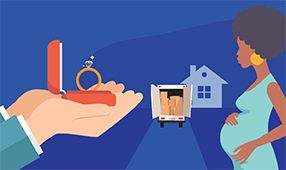Getting approved for a mortgage opens the financial “door” to owning a home. But before you apply, you’ll want to make sure you can readily qualify. By doing some legwork in advance, you can improve your chances for a loan approval while getting the lowest interest rate possible, which can save you a bundle in monthly costs over the length of your loan. Take the following five “must do” steps ahead of time and you’ll better position yourself to do just that.
1. Check your credit report and address any issues
According to Experian, a score of 700 or above is considered “good,” and 800 or above is excellent. Most scores fall between 600 and 750. And the higher your credit score, the better your loan terms can be.
It’s essential to go through all three of your credit reports thoroughly and correct any score-impacting issues, from simple clerical errors to problems such as duplicate accounts that make your debt look higher than it really is. And look for fraudulent accounts, such as unpaid charges on a card that you never owned.
Address legitimate, unresolved non-payments as well, such as to a utility or local county tax department if you moved frequently when younger. “In these cases, contact the collection agency and negotiate a settlement,” says Carrie D. Gusmus, a professional mortgage loan originator and senior vice president at Greenwood Village, Colorado-based Cherry Creek Mortgage Company. “Resolving this often only takes pennies on the dollar.”
The Federal Trade Commission provides important information about getting your free credit reports. If you find any errors, MyFICO.com explains the steps you can take to correct them.
2. Pay down debt to better your credit utilization ratio
To help raise your credit score (and possibly lower your mortgage interest rate), you’ll want to keep your credit utilization ratio—the amount of credit you owe divided by the total amount of credit you have available—to 30% or less. For example, if you have a combined limit of $10,000 on your credit cards, you don’t want to have any more than $3,000 in combined unpaid charges on them. “If you are exceeding this or even maxing out your cards,” Gusmus says, “look to pay them down to below 30%. Then pay down or eliminate installment debt, like a car or student loan.”
3. Gather recent financial statements
If there’s one certainty about applying for a mortgage, it’s that you should expect to provide plenty of documentation about the state of your earnings and finances. These documents may include your last two years’ worth of earnings and tax returns, as well as your most recent retirement/investment statements and up-to-date information about any existing debts. “Special circumstances like child support, alimony/palimony and trust income will require additional documentation,” Gusmus says. “So prepare early by holding on to the proof that you receive this income.”
4. Determine what you can legitimately spend
There’s lots of advice out there about how much of a mortgage you can take on. Most financial advisors say that your monthly home loan expense should account for no more than 36% of your gross income, according to Bankrate.com. “But much of this depends upon your personal circumstances,” Gusmus says. “Some lenders allow up to 40% depending upon the strength of the rest of your application, such as how much you’re putting down, your credit score, job stability and additional assets.”
If you don’t already have a budget, now may be the perfect time to start. Look back through your monthly spending to see if you have the wiggle room to take on the extra expenses of owning a home, such as maintenance, private mortgage insurance (PMI) if you don’t have a 20% down payment, homeowners insurance and property taxes. Understanding where your money goes can help you determine a right-sized mortgage. You can get a general idea using this calculator, but remember that the amount you qualify for may be higher than the mortgage amount you can comfortably live with.
5. Learn about loan options and discount programs for teachers
There are many different fixed and adjustable rate loans to choose from, along with terms ranging from 10 to 30 years or more. The Consumer Financial Protection Bureau has a helpful guide that explains many of these options and how they can affect the life of your loan. It’s important to understand these differences so you can make an informed choice.
You can also take advantage of mortgage discounts for teachers. For example, the Good Neighbor Next Door Sales Program, from the U.S. Department of Housing and Urban Development (HUD), offers discounts of 50% from the list price of a home in certain areas. You’ll need to live in the home for a minimum of three years.
You can also find grants and other financial support specific to your state through the Teacher Next Door program.
Your best first step: Seek expert advice
You don’t have to sort through all of this on your own. “It’s best to work with a mortgage professional to understand and assess these options,” Gusmus says. “Before hiring someone, ask for referrals from family and friends, and then check references. This is a big decision and price isn’t the prime factor—trust is.”
To learn more about preparing for the mortgage application process, read about five things you shouldn’t do before applying for a home loan.












